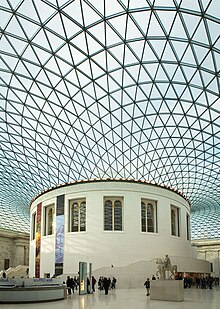Thin-shell structure




Thin-shell structures are light weight constructions using shell elements. These elements are typically curved and are assembled to large structures. Typical applications are fuselages of aeroplanes, boat hulls and roof structures in some buildings.
A thin shell is defined as a shell with a thickness which is small compared to its other dimensions and in which deformations are not large compared to thickness. A primary difference between a shell structure and a plate structure is that, in the unstressed state, the shell structure has curvature as opposed to plates structures which are flat. Membrane action in a shell is primarily caused by in-plane forces (plane stress), though there may be secondary forces resulting from flexural deformations. Where a flat plate acts similar to a beam with bending and shear stresses, shells are analogous to a cable which resists loads through tensile stresses. Though the ideal thin shell must be capable of developing both tension and compression. [1]
Architecture
See also
- Tensile and membrane structures
- Vladimir Shukhov
- Buckminster Fuller
- Eero Saarinen
- Frei Otto
- Norman Foster
- Concrete shell
- Gridshell
- Geodesic dome
- Hyperboloid structure
- Panrussian Exposition 1896
- Félix Candela
References
This article needs additional citations for verification. (June 2008) |
- ^ Chen, Wai-Fah, Handbook of Structural Engineering, 1997 CRC Press
External links
- Thin-shell structures
- Double thin-shells structures
- Hypar & Concrete Shells
- Lattice and grid shell structures
- Past and Future of Grid Shell Structures
- Shape optimization of Shell and Spatial structure
- Lattice Shell for Space Vehicles
- International Association for Shell and Spatial Structures
- “Vladimir G. Suchov 1853-1939. Die Kunst der sparsamen Konstruktion.”, Rainer Graefe und andere, 192 S., Deutsche Verlags-Anstalt, Stuttgart, 1990, ISBN 3-421-02984-9.
